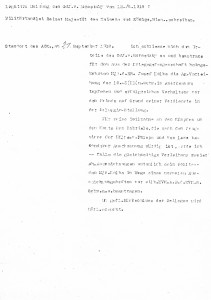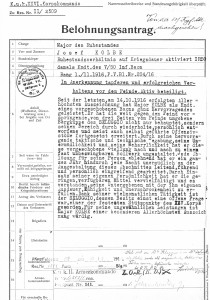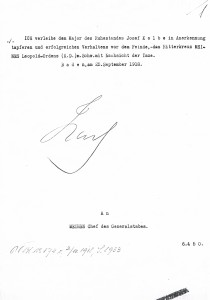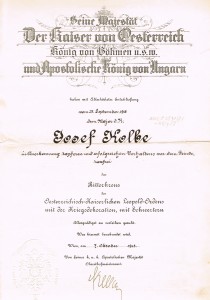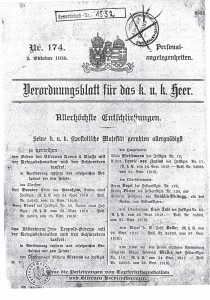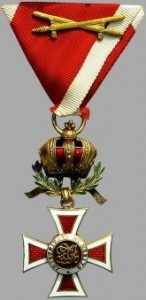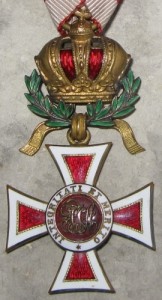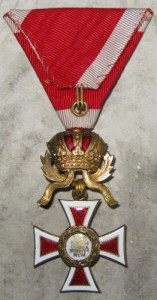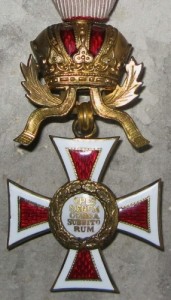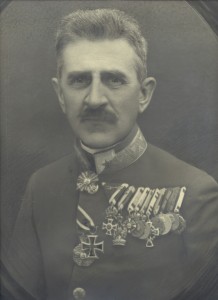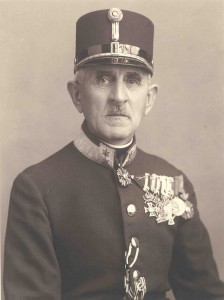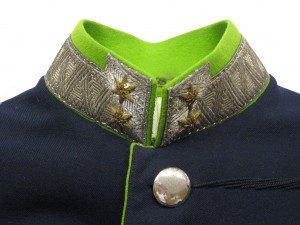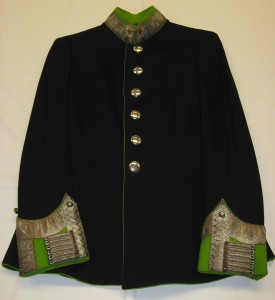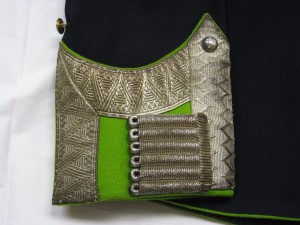The Imperial Austrian Order of Leopold was instituted by Emperor Franz I on 8 January 1808, on the day of his engagement to his future third wife, Maria Ludovika Beatrix von Modena. The order was to be called the Order of Rudolf, after Rudolf of Habsburg, then the Order of Franz, after its founder, but it was finally decided to name it after Franz’s father, Leopold II.
It was originally awarded according to three grades: Grand Cross, Commander and Knight, but this was amended by imperial decree, which stipulated that the senior grade be split in two, establishing four grades: Grand Cross, First Class, Commander and Knight. Up until 18 July 1884 the Grand Cross conferred the title of Privy Councillor on the recipient, the Commander’s Cross the status of baron and the Knight’s Cross that of hereditary knight.
The order consisted of a gold cross pattée, enameled red in the centre with white enamel edging. The centrefield on the obverse bore the elaborately entwined initials FIA (Franciscus Imperator Austriae) in gold on a red enamel background, bordered in white with the inscription INTEGRITATI ET MERITO (for integrity and merit). The reverse of the centrefield bore the motto of Leopold II: OPES REGUM CORDA SUBDITORUM (the deeds of the King win the hearts of his subjects) in gold lettering on a white enameled background, surrounded by a wreath of gold oak leaves. The Commander’s and Knight’s crosses were surmounted by a gold imperial crown out of which flowed a golden sash. The Knight wore the order on his left breast, suspended on a red tri-fold with white outer stripes.
The war decoration was introduced on 23 February 1860 for bravery in face of the enemy. This took the form of two crossed laurel branches below the crown and to each side of it, over the sash. A further distinction was the crossed swords, which the Knight wore on the ribbon.
Major Josef Kolbe was awarded the Knight’s Cross of the Order of Leopold with the war decoration and swords on 25 September 1918, after his return from captivity in Italy. The fact that he received the silver Military Merit Medal and the Order of Leopold was in large part due to the efforts of General Ernst von Horsetzky, Commander of the 3rd Edelweiss Division, who in July 1916 had sent the then Captain Kolbe to reconnoitre Monte Seluggio with a view to establishing a forward defensive position after the May Offensive in Trentino. He ensured that Major Kolbe’s actions, hitherto unrecognized because of his nine month captivity and two month convalescence period, did not remain unrewarded, overruling Major General Laxa’s recommendation for the silver Military Merit Medal only.
The award of the Order of Leopold was not, however, accompanied by Major Josef Kolbe’s promotion to a rank worthy of its prestige. He was convinced that this lack of recognition stemmed from the fact that he had been retired when war had broken out and that, as such, could not aspire to the same distinctions as a serving officer, despite his proven actions over and above the call of duty. Further efforts were no doubt made on his behalf and he was finally promoted to the rank of Lieutenant Colonel sometime between 1921 and 1924.
Sources:
War Archives, Vienna: http://www.oesta.gv.at/site/6154/default.aspx
Museum of Military History, Vienna: http://www.hgm.or.at
http://en.wikipedia.org/wiki/Order_of_Leopold_(Austria)
http://de.wikipedia.org/wiki/Österreichisch-kaiserlicher_Leopold-Orden
http://www.austro-hungarian-army.co.uk/leopold.htm

